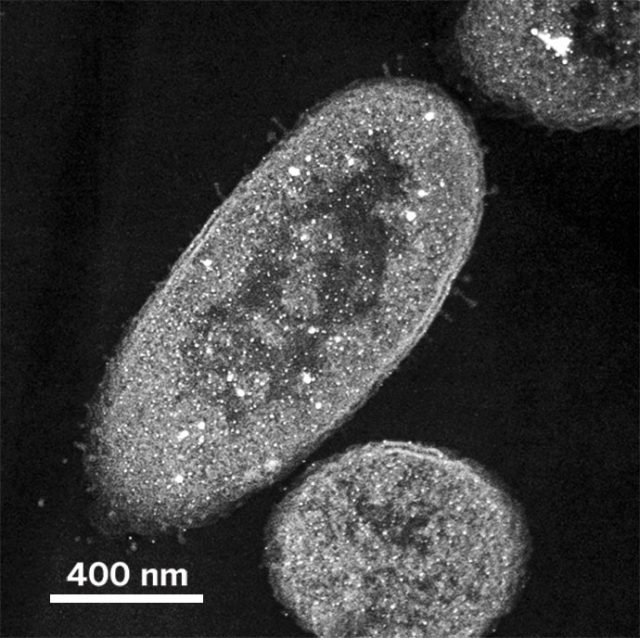“Who would have known zombies existed amongst bacteria as well? *cues eerie music*”—Just as how you see it in the movies, a bio-engineered virus causes humans to turn into a never ending brain-eating walking machine. A popular biocidal metal used for centuries, silver has the ability to turn bacteria into, well, zombies. Silver, in its ionic form Ag+, penetrates the membranes and kills living bacteria. The silver then cozies their way in these dead bacteria that serves as a silver reservoir. But here’s why this may relate to your disinfectant product.
Where Can You Find Silver Nanoparticles These Days?
“Hey, Dr Selina. Did you know that the surgical suit you’re wearing has built-in antimicrobial activity? Apparently it’s because of embedded silver nanoparticles.” —Nanotechnology, specifically the application of silver nanoparticles, have been widely used in the healthcare, food, and other industrial areas due to its various unique properties either physically, chemically, or biologically. You can find these silver nanoparticles on implant materials such as catheters, stents, bandages, surgical scrub suits, air filters, and deodorizing sprays—you’re probably wondering how too!—that promotes antimicrobial activity when in use. These coats are also not limited to materials such as textiles, plastics, paint, latex, and ceramics.

Just for a bit, I’d like to bring your focus towards the use of silver nanoparticles as a disinfectant to manage infectious diseases. Silver nanoparticles have been found to be effective against a wide group of microorganisms such as Staphylococcus aureus, Pseudomonas aeruginosa, Bacillus subtilis, Candida albicans, Aspergillus niger (now commonly referred to as Aspergillus brasiliensis), HIV, Hepatitis B virus, and more. Did you know that most of the organisms mentioned are representative microorganisms tested according to the European Standards?
“TECOLAB, how can I know if my silver nanoparticle-coated shirt has good antimicrobial properties?”—You’ve come to the right place! We offer a wide range of standard test methods to evaluate the efficacy of your nanoparticle coating according to your product category! Some of the test methods that we can offer are ISO 20743 (antibacterial property of textiles), ISO 18184 (antiviral property of textiles), ISO 22196 (antibacterial property of plastics), and ISO 27447 (Antibacterial property of ceramics). Let us know what type of product you would like to test and we’d recommend you the suitable test method!
Can the Antibacterial Effect of the Coating Last Longer Due to the Zombie Effect?
“Ooooooo, you should read this!”—Mr David Anvir and his colleagues from Hebrew University of Jerusalem had discovered the zombie effect theory with silver nitrate-treated Pseudomonas aeruginosa. Did you know that these Pseudomonas zombies caused over 99.99% reduction of their own kind during this experiment? Here’s how they did it!

Freshly prepared Pseudomonas bacteria were treated with silver nitrate. After the exposure time, the mixture was centrifuged to separate the supernatant (containing only silver ions) and dead bacteria pellet, herein known as the zombie bacteria. The supernatants containing silver ions were then filtered to prevent any bacterial contamination. After filtration, the supernatant and zombie bacteria (pellet) were exposed to their prey: viable Pseudomonas bacteria. The surviving bacteria after exposure to silver ions and zombie bacteria were then compared. We all know that Ag+ expresses excellent antimicrobial activity towards living bacteria, but how did the zombie bacteria fare?
Although these zombie bacteria do not physically bite living bacteria, turning them into zombies, it’s almost quite similar. Due to the Le-Chatelier’s principle, also known as the Equilibrium Law, stored silver are released from the zombie bacteria, leaching onto new unoccupied bacteria, causing system shut down. Although now that you think about it, these zombie bacteria do not directly kill live bacteria but because of their ability to store silver, these dead bacteria facilitate in the silver’s antibacterial mechanism.
Would you like to determine if your product has any residual or zombie effect? Contact us here and we can customize the test for you!
Reference:
1. Wakshlak, RK., Pedahzur, R. & Avnir, D. Antibacterial activity of silver-killed bacteria: the “zombies” effect. Sci Rep 5, 9555 (2015)
2. Wilson, E. K. (2015). The Reason for Silver Nitrate’s Prolonged Microbial Toxicity. Retrieved from: https://cen.acs.org/articles/93/i18/Reason-Silver-Nitrates-Prolonged-Microbial.html

